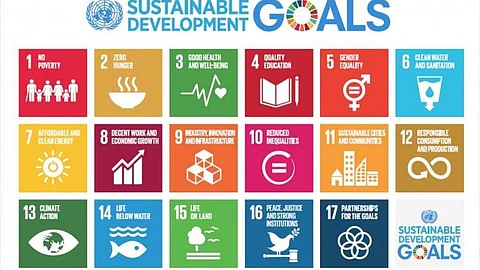
- Topics
- Feature
- Opportunities & Events
- About
- Hindi Portal
- Data
- Topics
- Feature
- Opportunities & Events
- About
- Hindi Portal
- Data

India ranks 121 in the global Sustainable Development Report, 2022
In the 2022 Global Index of Sustainable Development Report, India ranked 121 out of 163 countries. Since 2020 and 2021, the ranking has continued to decline. India's major challenge, as per the report, is achieving 11 of the 17 Sustainable Development Goals, which has resulted in a decline in its ranking.
Progress towards SDG 2 on ending hunger, SDG 3 on good health and well-being, SDG 6 on clean water and sanitation, and seven other SDGs is similar to 2021, while SDG 8, ensuring decent work, has become more challenging.
The overall performance of India on climate action - SDG 13 - has slipped from 2019-2020, mainly due to eight states - Bihar, Telangana, Rajasthan, Uttar Pradesh, Karnataka, Andhra Pradesh, Punjab, and Jharkhand - whose scores have dipped under SDG 13 in the past two years. (Down to Earth)
CSE’s recent environment report poses serious climate change concerns
A report by the Centre for Science and Environment (CSE) titled State of India's Environment 2022: In Figures warns that five Indian states and two union territories, namely Assam, Arunachal Pradesh, Sikkim, Bihar, Himachal Pradesh, Jammu and Kashmir, and Ladakh, face increasing danger from water spread. According to the report, over a third of India's coastline experienced some degree of erosion between 1990 and 2018, with West Bengal suffering the most erosion.
In addition, the report reveals that three out of every four river-monitoring stations in India have reported alarming levels of heavy toxic metals, and one-fourth of the stations, spread across 117 rivers and tributaries, have recorded high levels of two or more toxic metals.
(NDTV)
Water levels in most of India’s reservoirs and river basins in a grim state
As per the data from the Central Water Commission (CWC), 140 important reservoirs in the country have only 32 percent live storage compared to their capacity. This is due to the absence of pre-monsoon rainfall in large parts of the country combined with heat waves. River basins such as Sabarmati, Mahi, and Mahanadi have storage below the average of the last 10 years. Moreover, storage is less than full capacity in all 13 river basins including Ganga which has just 39.89 percent storage, Narmada 23 percent and Godavari and Krishna 31.64 and 23.92 percent, respectively.
The data also reveals that Hariharjhor reservoir in Odisha, Nanak Sagar reservoir in Uttarakhand and Tattihalla reservoir in Karnataka had zero storage. While at least eight states have below-normal storage in their reservoirs, at 35 percent Odisha is at the highest departure from normal storage.
(Down to Earth)
Need to explore alternative sources of energy in the long-run: NDMA
In the wake of the 2021 Chamoli floods that killed at least 80 and left 124 missing, the National Disaster Management Authority (NDMA) has compiled a report that urges a shift to alternative sources of energy over reliance on hydropower from Uttarakhand in the long run. Moreover, according to the year-long study of the disaster, many of the hydropower plants in the Himalayan region were built in environmentally sensitive areas.
As stated in the report, lack of predictive thinking by the district administration and the project proponents, as well as the lack of early warning systems, are also factors that contributed to the disaster taking on massive proportions.
The report warns about the impending risks that remain due to debris from the disaster forming an artificial lake and dam in the Raunthi Gadhera valley. (The Print)
Villagers in Gujarat go to great lengths to save critically endangered saras crane eggs
Residents of Ganasar village in Gujarat have turned one acre of farmland into a makeshift 'artificial wetland' to protect endangered Saras crane eggs.
Several efforts have been made by the villagers to save the eggs over the past one month. First, they used pots and buckets to fill the farmland with water, then created channels to divert water from a nearby canal.
Villagers are also on guard 24x7 to prevent wild animals and dogs from eating the eggs. In 2010, there were only 1,900 of the Saras cranes left in the state; the number is estimated to have decreased further to 600 in the past decade. (The Times of India)
This is a roundup of important news published from May 24 – June 7, 2022. Also read policy matters this fortnight.